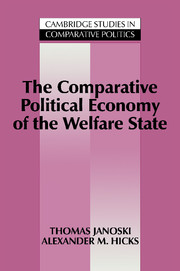Book contents
- Frontmatter
- Contents
- List of contributors
- List of tables and figures
- Preface
- 1 Methodological innovations in comparative political economy: an introduction
- PART I TIME-SERIES ANALYSIS
- PART II POOLED TIME-SERIES AND CROSS-SECTIONAL ANALYSIS
- PART III EVENT HISTORY ANALYSIS
- PART IV BOOLEAN ANALYSIS
- 12 Introduction to qualitative comparative analysis
- 13 A qualitative comparative analysis of pension systems
- 14 The politics of social security: on regressions, qualitative comparisons, and cluster analysis
- 15 Conclusion: quo vadis political economy? Theory and methodology in the comparative analysis of the welfare state
- Author index
- Subject index
13 - A qualitative comparative analysis of pension systems
Published online by Cambridge University Press: 05 June 2012
- Frontmatter
- Contents
- List of contributors
- List of tables and figures
- Preface
- 1 Methodological innovations in comparative political economy: an introduction
- PART I TIME-SERIES ANALYSIS
- PART II POOLED TIME-SERIES AND CROSS-SECTIONAL ANALYSIS
- PART III EVENT HISTORY ANALYSIS
- PART IV BOOLEAN ANALYSIS
- 12 Introduction to qualitative comparative analysis
- 13 A qualitative comparative analysis of pension systems
- 14 The politics of social security: on regressions, qualitative comparisons, and cluster analysis
- 15 Conclusion: quo vadis political economy? Theory and methodology in the comparative analysis of the welfare state
- Author index
- Subject index
Summary
There is nearly universal agreement in advanced capitalist democracies today that it is the responsibility of national governments to provide or at least sanction old-age support programs. Public expenditures on these programs have grown dramatically over the post–World War II period, and today expenditures on programs for the elderly outweigh expenditures on other welfare programs in most advanced countries (Quadagno 1987). Despite these commonalities, there is striking diversity among the advanced countries in how systems of old-age support are organized. Systems vary in the relative importance of public and private programs, the degree to which benefits are tied to contributions associated with paid labor, the degree to which programs have special provisions for different occupational groups or for civil servants, their relative administrative costs, and in many other ways.
Scholars have proposed a variety of explanations for these broad national differences. Three general explanations are discernible in the social scientific literature on the welfare state. According to the “logic of industrialism” explanation, both the growth of the welfare state and cross – national differences in “welfare state effort” – including pension expenditures – are by-products of economic development and its demographic and social organizational consequences (Wilensky 1975, Pampel and Williamson 1985). The “political class struggle” argument contends that the level of working-class mobilization and the strength of Left parties are the primary determinants of both the size of welfare state programs and their redistributive impact (Stephens 1979; Korpi 1983; Myles 1984; and Esping-Andersen 1990).
- Type
- Chapter
- Information
- The Comparative Political Economy of the Welfare State , pp. 320 - 345Publisher: Cambridge University PressPrint publication year: 1994
- 58
- Cited by

